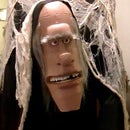Introduction: Halloween Time Machine
Hello all! So this halloween I decided to build a simulator ride for the back yard of my haunt! This ride will have three LCD's running to simulate windows, moving dials, flickering lights, and even vibrating seats! Let's take a look at the steps required to build something like this.
Step 1:
Step 2:
Step 3:
Step 4:
Next up you should build a frame for the bench seat. I left the frame wide in the middle so I can add a door so that underneath I can have a subwoofer and powerstrips to power the ride equipment. I later skin this with MDF wood and put a back on it made of MDF as well.
Step 5:
Step 6:
Next up is making the new wood look old. To make it look weathered I first put on a coat of Rustoleum Wood Stain in the Sunbleached color. This made the wood all a uniform light grey, which looked good, but kinda flat. To add the real weathered look, I then took some black latex paint and watered it down a whole bunch with water till it was super thin. I then brushed that all over the time machine, which allowed it to soak in randomly in the pits of the wood. Looking good!
Step 7:
Next up I made an instrument panel to go on the door above where I will mount the LCD screen. It's just a box made of wood that's deep enough for the servo motors to sit inside. The servo motors act as the dials and are just mounted to a piece of plexiglass that's been spray painted black on the backside. I then made some stickers that looked like dial readouts and stuck those to the plexi. The chrome plastic pieces I found on ebay for a couple bucks apiece. The servos are all attached to a Pololu USB Servo controller board.
Step 8:
The seats I don't really have a super good pic of, but they were just massage chair seat cushions that had a on off switch. I left the switch in the on position and cut the line on the positive power side and attached it into this board seen here. This is a relay that can be activated by being sent servo position commands. It's made by Basic Micro and is very sexy. So, in my software it just thinks a servo is hooked up. When I tell it to move the servo from the home position, it activates the relay, which in turn, activates the vibrating seats.
Step 9:
Next I made a cheapo light dimmer by attaching a servo motor to a dimmer switch. Using JB Weld, I glued a circle servo attachment head to the dial on the dimmer switch. When it dried I just plugged the servo in and held them all in place with some wood. Works great! Here's a schematic as well for how I wired up the lights so that they could just be plugged into a power strip.
Step 10:
Step 11:
Next up is to program the ride servos using the software which will control the ride. The software I used, Visual Show Automation (or VSA for short) is made by a company called Brookshire. It's a great piece of software. Each servo gets its own line on the timeline. You place your video and audio tracks and tell VSA which monitors need to display which video. You can then hook up a joystick to the computer, hit play in VSA, and move one of the servos in realtime using the joystick as the video plays. After you do this for each servo, you're done and ready to go!
Step 12:

Third Prize in the
Halloween Decorations Challenge

Participated in the
Halloween Props Challenge













